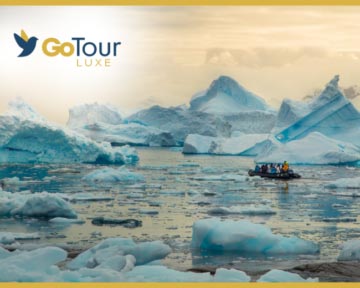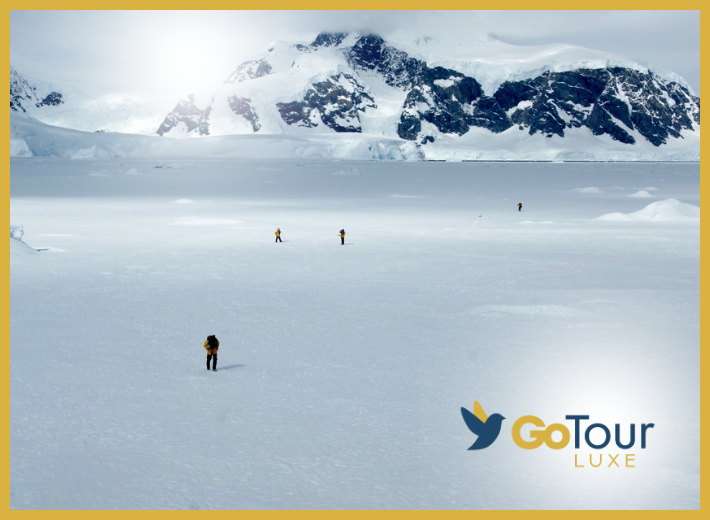Conquering Antarctica’s Weddell Sea

The Weddell Sea, a vast expanse of frozen ocean locked within the icy embrace of Antarctica, beckons explorers with its untouched beauty and formidable dangers. Its frigid waters, home to emperor penguins and colossal icebergs, have whispered tales of adventure for centuries. Join us as we unveil the Weddell Sea’s secrets:
Sliding into the frigid teal water, I’m instantly glad for the three pairs of socks I’m wearing inside my dry suit. I slowly skirt the jagged edge of an iceberg flaring out beneath the surface, careful not to veer too close should it suddenly flip and take me with it. Trying not think about the many ways I could meet a grisly end in the icy abyss of Antarctica, I shift my focus to what’s directly in front of my snorkel mask: thousands of tiny gelatinous creatures that look like they come from another world.
“We can go to the moon but there are still so many things on this planet that we don’t understand,” muses expedition team leader Florence ‘Flo’ Kuyper at the beginning of our voyage. Indeed, out here, in one of the wildest and most remote corners of the planet, I feel like I’m observing an alien species through my goggles.
Then, suddenly, there’s a flurry of flippers and GoPros as it comes to the attention of our small group of polar snorkellers that we’re not alone. Momentary terror at the sight of a dark shape moving towards us under the water converts to sheer joy, as I realise it’s just a curious fur seal pup moving in for a closer look at the brightly coloured intruders bobbing in its icy turf. Playfully swimming rings around us, the young seal momentarily pauses to stare at me with big, round inky eyes before shooting off in a flash of glistening silver-grey fur. Gratefully accepting ‘Scuba Pete’ Szyszka’s help to haul my frozen body back into the Zodiac (it now makes perfect sense why the strong-armed Polish-Australian guides this activity), I’m so overwhelmed by our unexpected encounter that happy tears begin rolling down my crimson cheeks. I had expected my first trip to Antarctica to be an emotional experience, and I was right.
Only offered once or twice each season by small-ship operator Aurora Expeditions, our Wild Antarctica itinerary takes us directly through Antarctica’s ‘back door’ into the Weddell Sea, which laps the east coast of the Antarctic Peninsula. Described by Sir Ernest Shackleton as “the worst sea in the world”, the Weddell is legendary for its immense tabular icebergs, year-round sea ice and its role in maritime history — the latter making headlines in 2022 when the icy wreck of Shackleton’s ship, Endurance, was discovered almost 10,000ft beneath the surface. With its treacherous waters given a wide berth by the increasing number of polar cruising vessels now plying Antarctic waters, this lonely sea feels about as far off the grid as it gets, though I discover the satellite wi-fi still works surprisingly well on board.
There’s an undeniable savageness undercutting the surreal beauty of the Weddell Sea. Between the sea ice that’s still perfectly capable of trapping a modern polar vessel and the razor-sharp teeth of 850lb sea lions dozing on ice floes, the thought of being marooned in this unforgiving water world is quite simply terrifying.
The members of Shackleton’s failed Imperial Trans-Antarctic Expedition weren’t the only pioneering polar explorers to succumb to such a fate. The earlier Swedish Antarctica Expedition of 1901-1903 was forced to spend a second winter on Snow Hill Island when Antarctic, the ship due to collect expedition members in the summer of 1902-1903, failed to show up. As young geologist Otto Nordenskjöld and his men stockpiled penguins and eggs to survive another winter, the crew of Antarctic were forced to follow suit on Paulet Island further north after their ship was crushed by pack ice and sunk, foreshadowing the fate of Endurance in 1915. Miraculously, the crews of both expeditions, save for one soul lost on the Swedish voyage, survived their ordeal.
Home truths
As we climb out of Zodiacs on Paulet Island to visit the remains of a stone hut built by the crew of Antarctic, the stench of guano and death is overpowering. Picking our way between lounging seals and a smattering of adélie penguin corpses on a beach usually teeming with juvenile penguins at this time of the season, our bewildered guide, Antarctic historian Steve Martin, remarks that it’s the first time he’s seen so few adélies on this beach.
“You can say what you like about climate change, but it shows you that things are happening,” he says glumly, as I watch a skua (carnivorous seabird) scavenge the remains of an unlucky penguin abandoned by its kin.
It’s one of several moments on the expedition that make me reckon with my own footprint on our fragile planet. Conscious of the carbon-intensive nature of visiting Antarctica, steps I take to minimise my impact include travelling with an operator committed to reducing its own. Aurora Expeditions was certified carbon-neutral in 2021, and the X-BOW hull design of our ship, the Greg Mortimer, boosts energy efficiency while also making our journey smoother — a welcome bonus for my seasickness-prone self as we navigate 20ft swells during the Drake Passage crossing. In 2023, the Australian-based company, which is currently pursuing B Corp certification, released its inaugural Impact Report detailing its sustainability journey with refreshing detail.
Aurora Expeditions is also among a growing number of polar operators encouraging guests to contribute to citizen science during their trip. As we cruise between landing sites, naturalist and marine biologist Dr John Kirkwood schools me in the art of conducting a seabird survey to record on eBird — an online archive of bird-related data. And when Flo announces a spirited pod of humpback whales sighted off the bow, I race up to the observation deck to photograph their flukes (tails) to upload to whale-monitoring project, Happywhale. My contribution to science may only be small, but its impact on me, at least, is not insignificant, connecting me even more deeply to this wild place.
Modern explorer
With a king bed, en suite bathroom, balcony and a TV in my comfortably heated, polar-toned stateroom, it feels like cheating to consider myself an ‘expeditioner’, as Flo likes to call us. The creature comforts of the ship make it easy to forget that Antarctica, and particularly the Weddell Sea, remains a place where Mother Nature can unleash her fury at any given moment. It’s only when captain Oleg Klaptenko tells me diplomatically that his favourite expedition is every expedition that returns safely to port with all passengers and crew, ‘expeditioner’ begins to feel more appropriate than ‘guest.’
Polar snorkelling is one of several optional activities available to more adventurous expeditioners, hosted as frequently during the journey as conditions allow. On a picture-perfect day in Duse Bay, surrounded by oozing glaciers sparkling with a fresh dusting of snow, I join the kayakers for a paddle in a kaleidoscope of blues. The sapphire water is as still as glass as we glide across it under a bluebird sky. Weaving between bulging icebergs topped with seals, sea lions and a few clusters of penguins, it’s a similar experience to a Zodiac cruise. But the silence of the kayaks dials up the serenity while simultaneously amplifying the sounds of nature: the crunch of paddles carving through brash ice, the thunderous crumble of glaciers calving across the bay, and the snort of a sea lion watching us from its icy perch. With nothing between me and the polar depths other than a few layers of polyethylene plastic, it adds an exhilarating sense of vulnerability.
“As far as I know, a sea lion has never attacked a kayaker,” says our guide Daniel Stavert cheerfully upon my only-half-joking enquiry. On our meandering loop of the bay, we also encounter a shiny black iceberg, its translucent girth a vast departure from the white, blue and brown hulks of ice we’ve become accustomed to. “There are no particles in it to scatter the light,” Daniel explains. “This iceberg could be 10,000 years old.”
I relish the opportunity to connect with Antarctica in different ways. But expeditioners who choose not to participate in the optional programme don’t miss out. The Weddell is kind to us on our voyage, allowing included Zodiac cruises and onshore excursions to be hosted simultaneously to optional activities almost every day. And with a maximum of 132 passengers on board the Greg Mortimer, there’s no need to conduct landings in shifts, as bigger ships do to comply with International Association of Antarctic Tour Operators (IAATO) guidelines.
Setting foot on the frozen continent for the first time at Brown Bluff, on day five of the expedition, is a highlight, its icy beach packed with adorably awkward gentoo penguins. Visits to Otto Nordenskjöld’s restored hut on Snow Hill Island, and the relics of Whalers Bay in the South Shetland Islands, offer more intriguing glimpses into the area’s maritime heritage. And as we venture deeper into the icy wilderness, the Zodiac cruises between icebergs as big as city blocks leave us in open-mouthed awe.
Back on board, a packed programme of presentations and lectures infuses my brain with fun facts, as well as the tools to better understand the significance of the Antarctic ecosystem. “If you get too close to an adélie you’ll cop a spewing or a pooing,” warns Dr Kirkwood during a penguin talk. The pungent odour of the species’ abundant pink poop, coloured by their fondness of krill, is yet another polar extreme I soon find myself adjusting to.
On day six, at the southernmost point of our expedition — 64.24 degrees south, just over 100 nautical miles north of the Arctic Circle — Flo announces the polar plunge. Shivering in my swimwear as music blares from the aft deck, I’m impressed to see more than half of my fellow expeditioners (including my cold water-averse husband), as well as four members of the expedition team and two crew, join me in taking turns to leap off a floating platform into the freezing Weddell. The shared experience only elevates the sense of camaraderie that’s developing on our relatively intimate expedition, with a particularly large turnout at the bar that evening for pre-dinner drinks.
Despite the sun setting earlier each day during our late-summer voyage, there’s still plenty of daylight left following afternoon activities for a spot of whale-watching from the onboard sauna or outdoor hot tub before dinner. Marvelling at a humpback whale launching itself out of the choppy sea as I sink into the steaming tub one windy evening, I feel tears pricking at the corners of my eyes. The great privilege of experiencing Antarctica has overwhelmed me again. In a place where such a privilege should never be taken for granted, it feels fitting to let them flow.
Plan your polar plunge! Get expert tips and resources for Antarctic travel. Book your tour with our luxury travel agency today! Call us at 844-446-8687. For more travel tips and itineraries, check our Instagram @gotourluxe.
Reference: [https://www.nationalgeographic.com/travel/article/voyage-antarctica-weddell-sea]

